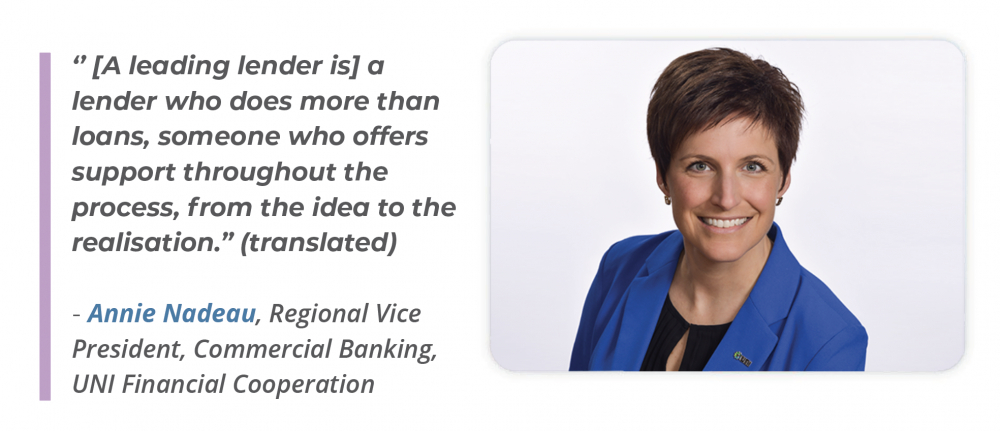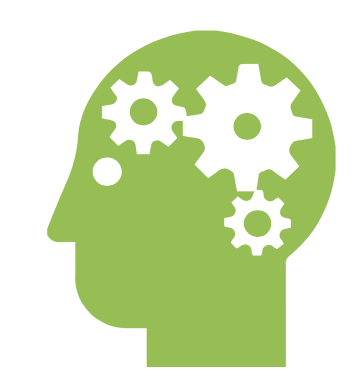8.1 Being a Leading Lender
Thanks to the strong ties lenders can develop with their clients, they can play a key role in the growth of women entrepreneurship from coast to coast. However, supporting women entrepreneurs as a lender is one thing; doing so as a leading lender is something else. So, what does it really mean to be a leading lender?
Some members from the Leading Lenders’ National Advisory Committee (NAC) shared their thoughts about being a leading lender:



There is no doubt that many lenders already exceed expectations and make a real difference in women’s entrepreneurial journeys. These lenders have certain qualities that allow them to stand out within the lending industry. Dedication, as Laura Didyk noted, is one of those attributes because ‘’a dedicated professional can help women entrepreneurs thrive.” When asked to share one essential quality needed to be a leading lender, many of the NAC members said the same thing: It is important to be a good listener to understand women entrepreneurs’ needs and motivations to better support them in their entrepreneurial journeys.
Fewer than 16% of Canadian businesses are majority women-owned, as opposed to over 63% for men in the same category.1 In other words, significant barriers still hinder the growth of women entrepreneurship in Canada. Lenders can help to break down barriers for many women seeking business financing. The experts (NAC) we consulted mentioned a number of major obstacles for Canadian women entrepreneurs:
Looking for expert advice from both the lending and business industry? Here are some of their suggestions for lenders seeking to support women entrepreneurs more effectively:
 Be aware of existing biases
Be aware of existing biases
Unfortunately, biases concerning women entrepreneurs are common. Therefore, it is critical for lenders to be able to recognize and address these biases to better support women entrepreneurs. Fortunately, many lending institutions offer their employees training in this regard—but there is still work to be done. For more on this topic, see tool 2.3 How to Overcome Biases and Stereotypes and our blog article 3 Steps to Recognizing Biases.
 Emphasize the importance of networking
Emphasize the importance of networking
Having access to a well-rounded entrepreneurial network is an important component of business success. Lenders can encourage their clients to build a network specific to their business model. Check out tool 7.4 for more on this topic.
 Key Ally
Key Ally
Lenders have a big influence on the women entrepreneurs they meet. By building a positive relationship with their clients and helping them throughout the process, lenders can become key allies in many women’s entrepreneurial journeys. For more, see tool 4.3 Entrepreneurial Relationships with Women.
 Getting to know your clients
Getting to know your clients
Through conversations that go beyond ratios and financial analysis, lenders can gain insight into women entrepreneurship. Discussions between lender and client can uncover women’s entrepreneurial motivations, resilience and needs.
 Recognize the specific characteristics of women entrepreneurship
Recognize the specific characteristics of women entrepreneurship
Lenders should be aware that there are some general differences between women and men entrepreneurs. Therefore, they should be able to recognize the specific characteristics of women entrepreneurship. In that respect, it’s not always the case that women entrepreneurs should be treated the same as men entrepreneurs. In fact, their realities are often quite different. Check out tool # 5 to learn more about the distinct features of women entrepreneurship
Our toolkit includes data taken from the 2017 Survey on financing and growth of small and medium enterprises. The 2022 Survey is available at the following link: https://www150.statcan.gc.ca/n1/daily-quotidien/220302/dq220302b-cansim-eng.htm
However, please note that the data included in this most recent survey is greatly influenced by the recent worldwide pandemic, making it difficult to compare it to the stats included in our toolkit which are based on a pre-pandemic period survey.
Some members from the Leading Lenders’ National Advisory Committee (NAC) shared their thoughts about being a leading lender:



There is no doubt that many lenders already exceed expectations and make a real difference in women’s entrepreneurial journeys. These lenders have certain qualities that allow them to stand out within the lending industry. Dedication, as Laura Didyk noted, is one of those attributes because ‘’a dedicated professional can help women entrepreneurs thrive.” When asked to share one essential quality needed to be a leading lender, many of the NAC members said the same thing: It is important to be a good listener to understand women entrepreneurs’ needs and motivations to better support them in their entrepreneurial journeys.
The importance of recognizing barriers to women entrepreneurship
Fewer than 16% of Canadian businesses are majority women-owned, as opposed to over 63% for men in the same category.1 In other words, significant barriers still hinder the growth of women entrepreneurship in Canada. Lenders can help to break down barriers for many women seeking business financing. The experts (NAC) we consulted mentioned a number of major obstacles for Canadian women entrepreneurs:- Lack of access to financing tailored to women entrepreneurs' unique needs
- Lower level of financial literacy, including financial confidence
- Lack of access to an entrepreneurial network
- Lack of financial equity
- Work/life balance (managing a home and managing a business)
- Biases
How can a leading lender better support women entrepreneurs?
Looking for expert advice from both the lending and business industry? Here are some of their suggestions for lenders seeking to support women entrepreneurs more effectively: Be aware of existing biases
Be aware of existing biasesUnfortunately, biases concerning women entrepreneurs are common. Therefore, it is critical for lenders to be able to recognize and address these biases to better support women entrepreneurs. Fortunately, many lending institutions offer their employees training in this regard—but there is still work to be done. For more on this topic, see tool 2.3 How to Overcome Biases and Stereotypes and our blog article 3 Steps to Recognizing Biases.
 Emphasize the importance of networking
Emphasize the importance of networkingHaving access to a well-rounded entrepreneurial network is an important component of business success. Lenders can encourage their clients to build a network specific to their business model. Check out tool 7.4 for more on this topic.
Lenders have a big influence on the women entrepreneurs they meet. By building a positive relationship with their clients and helping them throughout the process, lenders can become key allies in many women’s entrepreneurial journeys. For more, see tool 4.3 Entrepreneurial Relationships with Women.
Through conversations that go beyond ratios and financial analysis, lenders can gain insight into women entrepreneurship. Discussions between lender and client can uncover women’s entrepreneurial motivations, resilience and needs.
Lenders should be aware that there are some general differences between women and men entrepreneurs. Therefore, they should be able to recognize the specific characteristics of women entrepreneurship. In that respect, it’s not always the case that women entrepreneurs should be treated the same as men entrepreneurs. In fact, their realities are often quite different. Check out tool # 5 to learn more about the distinct features of women entrepreneurship
Become a Partner:
Organizations that encourage more women entrepreneurs to enter the entrepreneurial ecosystem are champions for change, and we’d like to hear from you. Please contact us at info@leadinglenders.ca for more information on how your organization could be listed as one of the Leading Lenders’ Partners.
Our toolkit includes data taken from the 2017 Survey on financing and growth of small and medium enterprises. The 2022 Survey is available at the following link: https://www150.statcan.gc.ca/n1/daily-quotidien/220302/dq220302b-cansim-eng.htm
However, please note that the data included in this most recent survey is greatly influenced by the recent worldwide pandemic, making it difficult to compare it to the stats included in our toolkit which are based on a pre-pandemic period survey.
Download & Print Tool
References
1 ISED (2018). Survey on financing and growth of small and medium enterprises (SFGSME), Table 40, 2017, Innovation, Science, and Economic Development Canada, Government of Canada, https://www.ic.gc.ca/eic/site/061.nsf/vwapj/SFGSME-EFCPME_2017_eng_public.pdf/$file/SFGSME-EFCPME_2017_eng_public.pdf (page consulted October 23rd 2020).
Disclaimer
All documents prepared for the LEADING LENDERS project were developed in line with the most appropriate and recent terminology. However, we recognize that terminology is subject to change over time. To the best of our ability, we have attempted to use terminology that respects the dignity and rights of all individuals.
All documents prepared for the LEADING LENDERS project were developed in line with the most appropriate and recent terminology. However, we recognize that terminology is subject to change over time. To the best of our ability, we have attempted to use terminology that respects the dignity and rights of all individuals.
Share:

